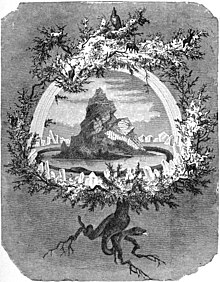
Back Yggdrasil Afrikaans Yggdrasill ALS إغدراصيلة Arabic İqqdrasil Azerbaijani Yggdrasil BAR Іггдрасіль BE-X-OLD Игдрасил Bulgarian Yggdrasil Breton Ígdrasil Catalan Yggdrasil Czech

Yggdrasil (from Old Norse Yggdrasill) is an immense and central sacred tree in Norse cosmology. Around it exists all else, including the Nine Worlds.
Yggdrasil is attested in the Poetic Edda compiled in the 13th century from earlier traditional sources, and in the Prose Edda compiled in the 13th century by Snorri Sturluson. In both sources, Yggdrasil is an immense ash tree that is central to the cosmos and considered very holy. The gods go to Yggdrasil daily to assemble at their traditional governing assemblies. The branches of Yggdrasil extend far into the heavens, and the tree is supported by three roots that extend far away into other locations; one to the well Urðarbrunnr in the heavens, one to the spring Hvergelmir, and another to the well Mímisbrunnr. Creatures live within Yggdrasil, including the dragon Níðhöggr, an unnamed eagle, and the stags Dáinn, Dvalinn, Duneyrr and Duraþrór.
Scholars generally consider Hoddmímis holt, Mímameiðr, and Læraðr to be other names for the tree. The tree is an example of sacred trees and groves in Germanic paganism and mythology, and scholars in the field of Germanic philology have long discussed its implications.